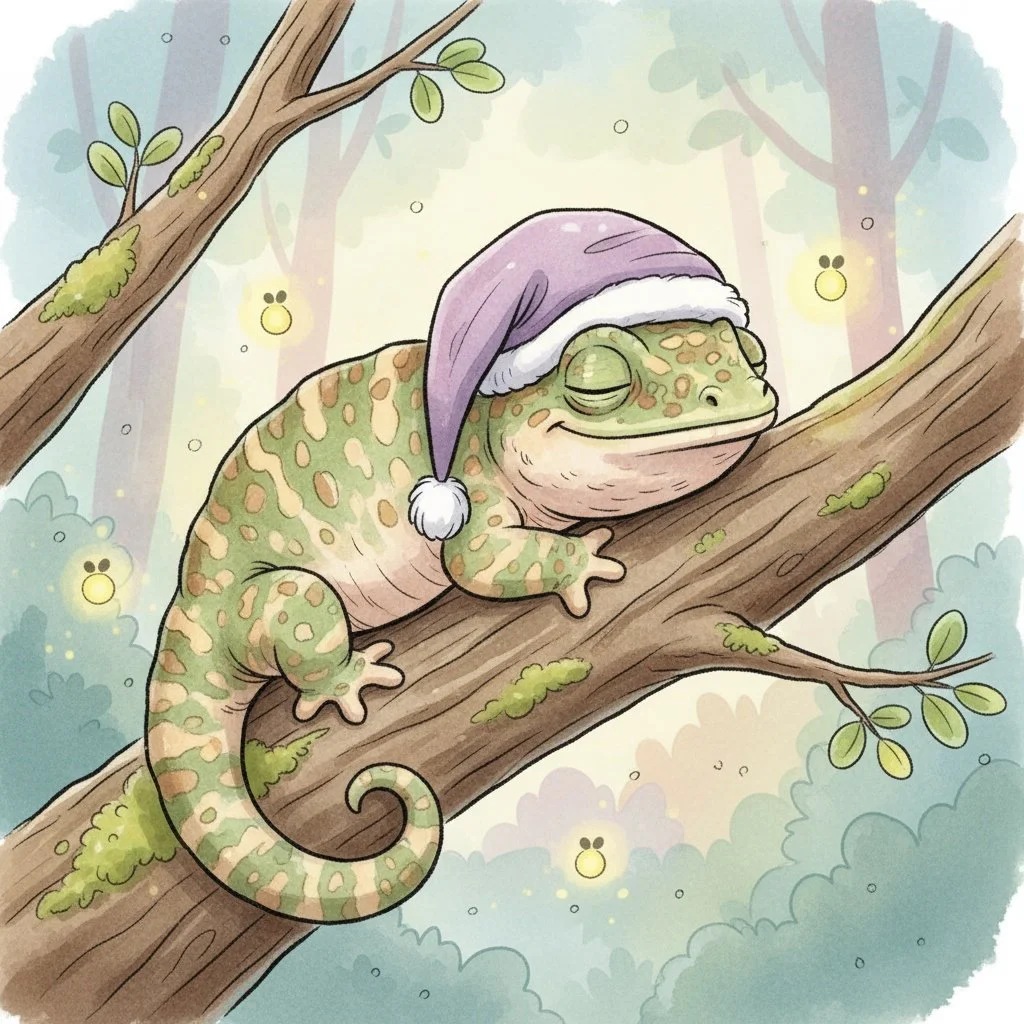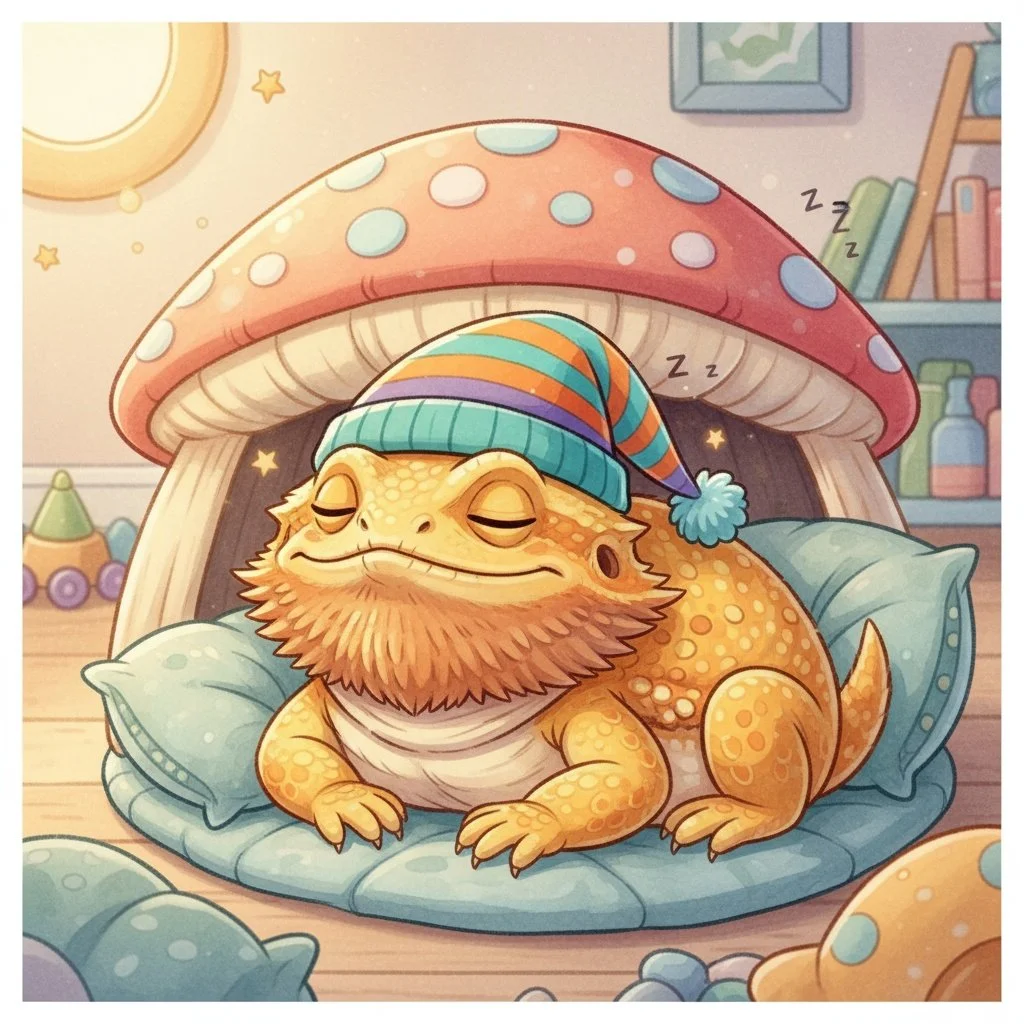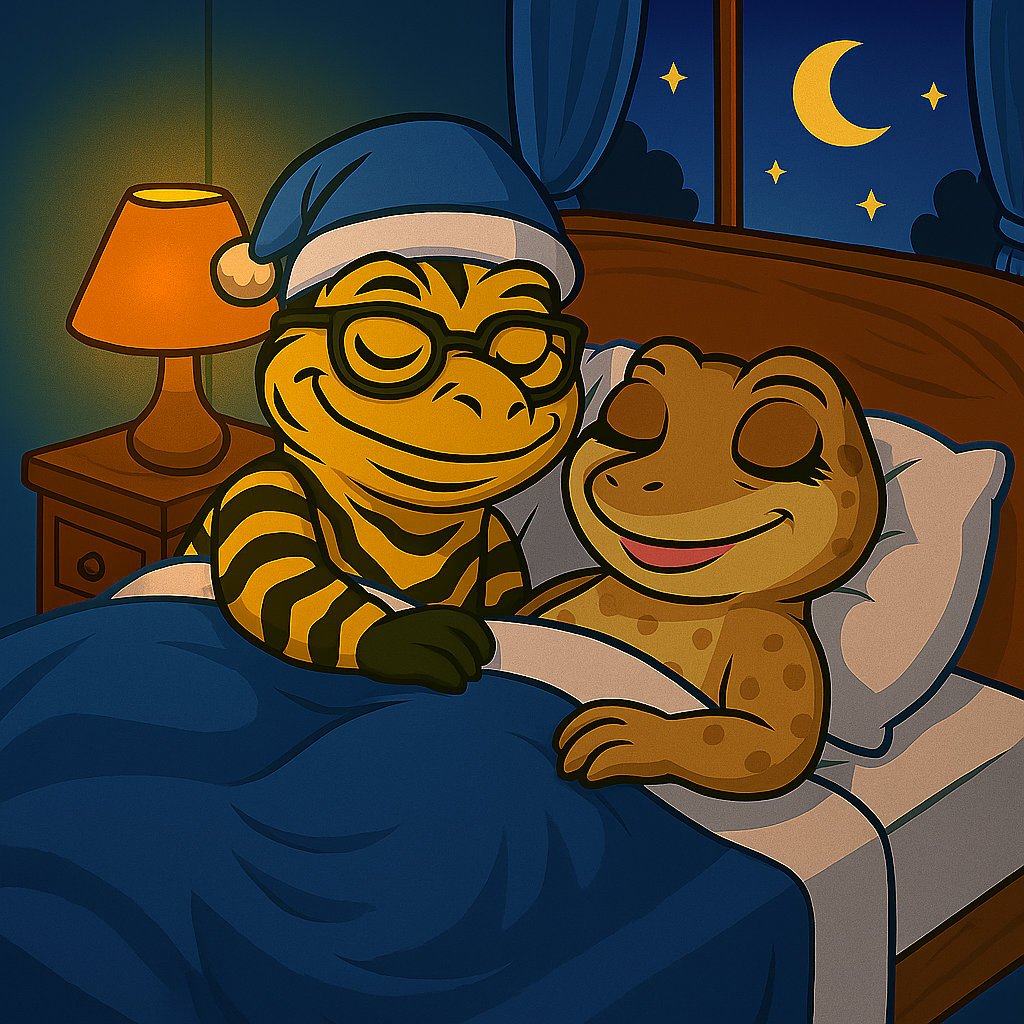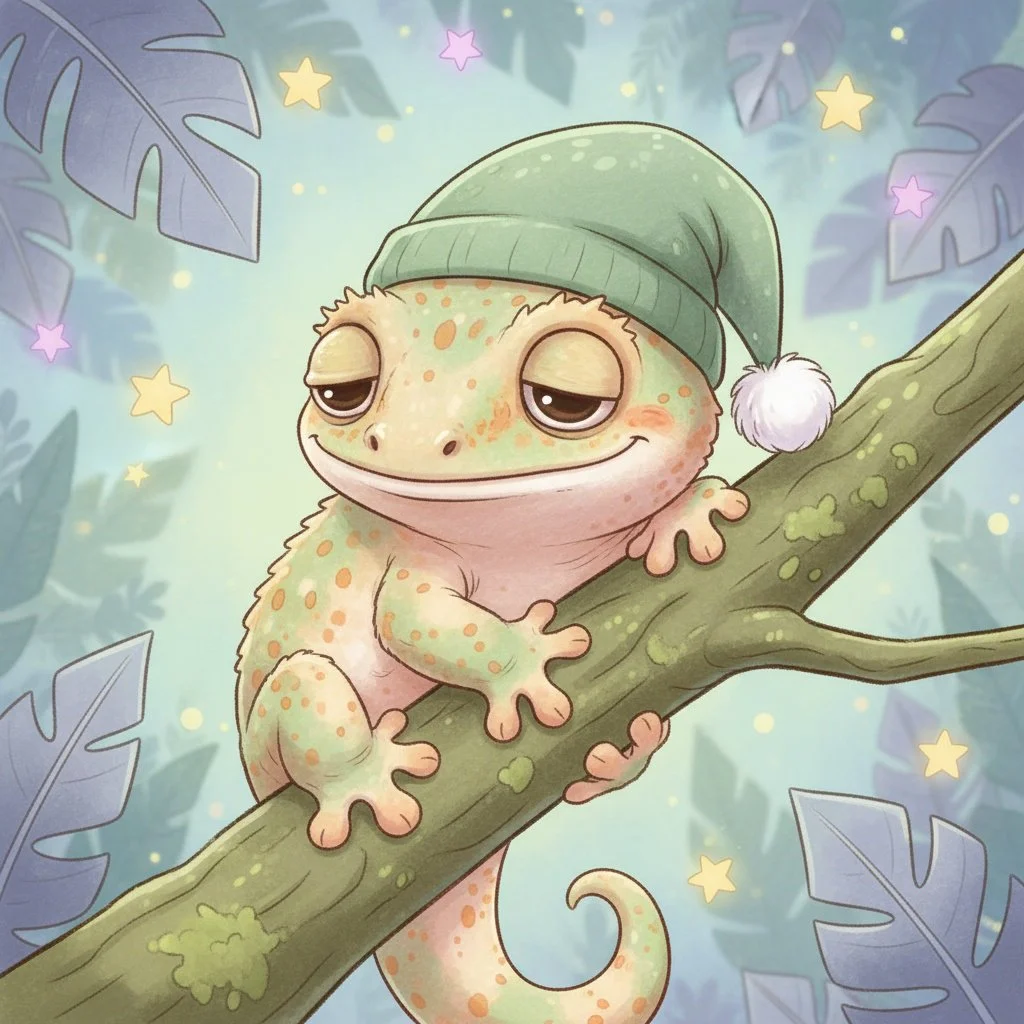Winter Sleepytime: Understanding Brumation in Our Scaly Friends
When winter rolls around and the days get shorter, something magical happens in the reptile world. Some of our scaly companions start acting a little… sleepy. They eat less, move slower, and spend more time hiding away. Don’t panic! This natural behavior is called brumation, and it’s perfectly normal for many reptiles.
Let’s explore what brumation means and how it affects each of the amazing kritters in our family!
What Exactly Is Brumation?
Think of brumation as the reptile version of a long winter nap—but it’s not quite the same as hibernation. Here’s the difference:
Hibernation (what mammals do): - Deep, continuous sleep - Body temperature drops dramatically - Metabolism nearly stops - Animals rely on stored fat for energy - They rarely wake up until spring.
Brumation (what reptiles do): - Light dormancy with periods of activity - Metabolism slows down but doesn’t stop - Body temperature lowers but stays responsive to environment - Reptiles may wake up to drink water or bask - They’re aware of their surroundings.
The biggest difference? A hibernating bear is completely out cold, but a brumating bearded dragon might pop out for a quick drink or a warm sunbath before heading back to bed. Reptiles are cold-blooded, so they respond directly to temperature changes in their environment rather than generating their own body heat like mammals do.
Brumation in Our Kiley’s Kritters Family
Even know we might miss the fun daily activity of our scaly friends while they brumate we realize it’s natural way of life for them and respect that. The urge to handle our friends at this time must be resisted - knowing that once brumation is complete we can again spend time with them after some well-deserved winter rest. Below is just some tidbits we have learned along the way, of course we are not professionals by any means, always consult an exotic veterinarian if you have any questions about your scaly friends and their sudden lack of activity during the cooler months.
Bearded Dragons ✓
Do they brumate? YES!
Bearded dragons are champion brumators. In the wild, they experience cooler Australian winters, and captive beardies often follow this natural rhythm. During brumation (typically late fall through winter), your beardie might: - Sleep for days or weeks at a time - Refuse food completely - Become less active and alert - Spend most time hiding or burrowing
Duration: Usually 1-3 months (December through February)
What we’ve noticed: Bilbo Draggins gets extra sleepy around November and wants to snuggle in his hide more than usual. We let him rest and just make sure fresh water is always available. He is still quite young though, at just over a year old, so he still eats his fair share of bugs throughout the winter months.
Uromastyx ✓
Do they brumate? YES!
These desert-dwelling lizards experience seasonal changes in their natural North African and Middle Eastern habitats. Uromastyx can enter brumation when temperatures drop and daylight hours shorten.
What happens: - Reduced appetite or complete food refusal - Less basking behavior - More time spent in hides or burrows - Lower activity levels
Duration: Typically, 8-12 weeks during winter months
Fun fact: Some Uromastyx keepers choose to prevent brumation by maintaining consistent temperatures and light cycles year-round, and that’s perfectly fine too! For us, as Pikachu and Eevee have successfully bred before, we choose to shorten the day light and heat cycle. They live together and this sends cues to Pika to settle down and give Eevee her some space.
Leopard Geckos ✓
Do they brumate? YES!
Leopard geckos naturally experience cooler winters in their native Afghanistan and Pakistan habitats. In captivity, they may enter a light brumation period.
What to expect: - Reduced feeding (eating every 10-14 days instead of weekly) - More time hiding - Less nighttime activity - Occasional emergence for water
Duration: Usually December through late February (2-3 months)
What we’ve learned: Our leopard gecko becomes less interested in mealtime during winter but still comes out occasionally. We keep offering food but don’t worry if it’s refused. When Lizzie does poke her head out, she also seems somewhat interested in being held for a few moments here and there. Otherwise, she does do a great job of sleeping during the cooler months!
Blue Tongue Skinks ✓
Do they brumate? YES!
Blue tongue skinks from Australia and Indonesia experience seasonal changes, and many captive skinks will naturally brumate.
Signs of brumation: - Dramatically reduced appetite - Spending days or weeks buried in substrate - Less responsive to handling - Seeking cooler areas of enclosure
Duration: Can range from a few weeks to several months (typically November through January or February)
Important note: Younger skinks (under 12 months) shouldn’t brumate, as they need consistent nutrition for growth. Our Pumpkin is now well over one year old and we expect that she might brumate this season. Although she is a like a lap dog and will be missed.
New Caledonian Geckos
Crested Geckos ~ (Sort of!)
Do they brumate? NOT REALLY—but they do slow down!
Crested geckos come from New Caledonia, where temperatures are relatively stable year-round. They don’t undergo true brumation, but they may experience a “cooling period” or winter slowdown.
What happens: - Slightly reduced activity - Less frequent feeding - More time resting - Reduced breeding behavior
Duration: A few weeks to a couple months during cooler weather
The takeaway: Cresties don’t need brumation like bearded dragons do, but a slight temperature drop (not below 65°F) can be healthy and may encourage breeding behavior in adults.
Gargoyle Geckos ~ (Sort of!)
Do they brumate? NOT REALLY—similar to crested geckos!
Gargoyle geckos are also from New Caledonia and behave much like their crested cousins. They experience a winter slowdown rather than true brumation.
What we see: - Mild decrease in appetite - Slightly less climbing and exploring - More time in hides - Reduced interest in breeding (for adults)
Duration: Variable, usually a few weeks during winter
Care tip: We maintain normal temperatures but allow for natural day/night cycles with shorter daylight hours in winter.
Leachianus Geckos (Leachies) ~ (Sort of!)
Do they brumate? NOT REALLY—but they appreciate a cooling period!
The largest gecko species, leachies are also from New Caledonia. Like their smaller relatives, they don’t undergo deep brumation but may slow down seasonally.
Winter behavior: - Reduced feeding frequency - Less active hunting behavior - More time resting in favorite spots - Decreased breeding activity
Duration: A few weeks to 2 months
Breeding note: Many breeders provide a 4-6 month cooling period for adult females to give their bodies a break from egg production.
Green Keeled-Bellied Lizards ? (Unclear!)
Do they brumate? POSSIBLY—but information is limited!
These beautiful lizards from Kenya and Tanzania are less common in captivity, so brumation behavior isn’t well-documented. Their equatorial habitat suggests they may not need brumation, but some keepers report seasonal slowdowns.
What we’ve observed: - Occasional periods of reduced activity during cooler months - Less frequent feeding - More time spent sleeping vertically in plants
Duration: Unknown, but likely brief if it occurs at all
Our approach: We maintain consistent temperatures and humidity year-round and let them set their own activity pace.
Snake Family:
Western Hognose Snakes ✓
Do they brumate? Yes — but only needed for breeding or natural cycles.
Pet hognoses can stay healthy without brumation if temperatures and photoperiod remain stable.
About Brumation:
Western hognose snakes come from areas with winter cooling, so brumation is a natural seasonal behavior.
Brumation Signs
Little to no interest in food
Increased hiding / reduced activity
Occasional movement to drink water
Typical Duration
6–12 weeks
Often December–February
Important Feeding Note
Stop feeding 10–14 days before cooling and wait for the snake to pass waste.
Never brumate a snake that hasn’t cleared its system or appears underweight or ill.
🎯 When Brumation is Recommended
Breeding projects
Mature, healthy animals
Keeper knows how to control temps/light
🚫 When to Avoid Brumation
Juveniles (<1 year)
Snakes not eating consistently
Sick or underweight animals
Unexperienced keepers without guidance
So far with Pancake and Maple Syrup they are a bit young still and we have not yet determined when to start brumation in advance of at least one breeding attempt. Most likely we will wait until young miss Maple is a year or two older.
Corn Snakes ✓
Do they brumate? Yes!
Corn snakes naturally brumate in the wild, and seasonal cooling is commonly used for healthy, mature breeding adults. However, pet corn snakes do not need brumation if kept on consistent heat and lighting — they stay perfectly healthy without it.
What to expect during brumation:
Little to no interest in food
Very low activity
Hiding in cool, sheltered areas
Calm and slower, but still responsive
Typical cooling parameters (breeding only):
58–62°F is ideal (safe range 55–65°F)
Duration: ~8–12 weeks during winter
Important preparation:
Stop feeding 10–14 days before cooling
Confirm last bowel movement
Lower temps gradually over 1–2 weeks
Our plan:
We will only brumate healthy, adult corn snakes if breeding. Otherwise, we’ll maintain normal temperatures year-round — pet corn snakes thrive without brumation. For Peaches we do not plan on breeding her so we will maintain status quo.
Ball Pythons ✗ (No!)
Do they brumate? NO—but they do experience seasonal changes!
Ball pythons are from tropical West Africa, where temperatures stay relatively warm year-round. They don’t brumate in the traditional sense, but they do have a “cooling season.”
What happens instead: - Reduced appetite (especially males during breeding season) - Slightly less activity - Normal alertness and responsiveness maintained - No need for temperature drops
Important warning: Temperatures low enough to trigger true brumation can be dangerous or fatal to ball pythons. They should always have access to proper heat, and ambient temperatures shouldn’t drop below 80°F.
Duration of slowdown: Variable, often October through February
Our Wanda and Cosmo are both very different. We see Wanda out at night and peaking her head out of her hide to watch our activity more during the day then Cosmo. They are also quite young, just going on two years, so we have not attempted to breed them just yet. Either way no noticeable difference so far in cooler month activity, but we maintain temperature and day/night cycle light activity.
Boa Imperators ~ (Not Really!)
Do they brumate? Not true brumation — but mild seasonal cooling may be used for breeding.
Boa imperators (often called "common boas" or formerly boa constrictors) come from Central & parts of South America where temperatures fluctuate, but not enough for true brumation. They can handle cooler periods better than tropical rainforest species — but cooling is optional, not required.
🌡️ If Cooling for Breeding (Advanced Keepers Only)
Typical breeding cooling practices:
Gradual feeding reduction
Lower activity
Still alert & reactive (not dormant like brumating colubrids)
Temps kept safely above 72°F (22°C)
Avoid going below:
70°F (21°C) — too cool for many boas and risky for respiratory health
Cooling Window:
6–10 weeks, with a slow cool-down and warm-up
Note: Many successful boa pairings happen without cooling at all — cooling just simulates a drier, slightly cooler seasonal shift.
🐍 For Pet Boa Imperators (No Breeding)
We will not cool our boas — they thrive with stable warmth and humidity.
General preferred temps:
Ambient: 80–85°F (27–29°C)
Warm spot: 88–92°F (31–33°C)
Cooler zone: ~78°F (25–26°C)
Stable warm conditions = consistent appetite, strong immunity, and reduced stress.
🚫 When to Avoid Cooling
Do not cool:
Juvenile boas (<2 years)
Snakes recovering from illness
Snakes not eating consistently
Pet boas not intended for breeding
No plans on attempting to cool them off this year. Both Ludo and Zoey are too new to our family, and we plan on keeping consistent temperatures and light cycles throughout their first year with us!
Rainbow Boas ~ (Not Really!)
Do they brumate? Not really! They're tropical snakes, so they don't brumate.
Breeders may use a gentle cooling period to encourage breeding, but it's not needed for pets. Rainbow Boas can be very tricky, especially when younger to care for. Consult with professional breeders and an exotic veterinarian before thinking about doing any sort of cooling for breeding.
If cooling for breeding:
No feeding during cooling
Gradual temp drop
Temps ~72–75°F
High humidity maintained
Length: 6–10 weeks
Pet care:
We will not cool our rainbow boa Sweetie. We’ll maintain 80–85°F temps and proper humidity year-round — exactly what they’re adapted for in nature!




Should You Let Your Reptile Brumate?
You should always consult an experienced exotic veterinarian.
This is a personal choice that depends on several factors:
Consider allowing brumation if: - Your reptile is healthy and at a good weight - They’re showing natural signs of wanting to slow down - You’re comfortable monitoring them during dormancy - The species naturally brumates in the wild - You’re interested in breeding (for appropriate species).
Avoid brumation if: - Your reptile is underweight or sick - They’re very young (under 1 year for most species) - You’re a first-time keeper and unsure about monitoring - The species doesn’t naturally brumate (like ball pythons).
Always remember: Brumation is optional for most pet reptiles. If you maintain consistent temperatures and lighting year-round, many species will skip brumation entirely and remain healthy and happy!
Final Thoughts from the Kiley’s Kritters Family
Brumation might seem scary at first—especially when your usually active reptile suddenly wants to sleep for weeks! But it’s a completely natural process that many reptiles have been doing for millions of years.
We’ve learned to trust our kritters and watch for their natural cues. Some years, certain reptiles brumate deeply. Other years, they barely slow down at all. Every reptile is different, and that’s what makes them so fascinating!
The most important thing? Pay attention to your individual animal, keep learning, and don’t be afraid to reach out to experienced keepers or reptile veterinarians if you have concerns.
Winter might mean naptime for some of our scaly friends, but it also means we get to appreciate the amazing adaptations that help reptiles survive in their natural habitats. Pretty cool, right?
Stay curious, keep learning, and give your kritters some extra love this winter—whether they’re wide awake or snoozing away!
Have questions about brumation or want to share your own experiences? We’d love to hear from you! Connect with the Kiley’s Kritters family on Facebook and Instagram.







